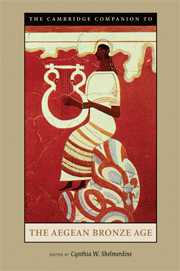Book contents
- Frontmatter
- 1 Background, Sources, and Methods
- 2 The Early Bronze Age in Greece
- 3 The Early Bronze Age in the Cyclades
- 4 Early Prepalatial Crete
- 5 Protopalatial Crete
- 5A Formation of the Palaces
- 5B The Material Culture
- 6 The Material Culture of Neopalatial Crete
- 7 Minoan Culture: Religion, Burial Customs, and Administration
- 8 Minoan Crete and the Aegean Islands
- 9 Minoan Trade
- 10 Early Mycenaean Greece
- 11 Mycenaean Art and Architecture
- 12 Mycenaean States
- 13 Burial Customs and Religion
- 14 Mycenaean Greece, the Aegean and Beyond
- 15 Decline, Destruction, Aftermath
- Glossary
- Select Bibliography
- Index
- Plate section
5B - The Material Culture
from 5 - Protopalatial Crete
Published online by Cambridge University Press: 28 November 2010
- Frontmatter
- 1 Background, Sources, and Methods
- 2 The Early Bronze Age in Greece
- 3 The Early Bronze Age in the Cyclades
- 4 Early Prepalatial Crete
- 5 Protopalatial Crete
- 5A Formation of the Palaces
- 5B The Material Culture
- 6 The Material Culture of Neopalatial Crete
- 7 Minoan Culture: Religion, Burial Customs, and Administration
- 8 Minoan Crete and the Aegean Islands
- 9 Minoan Trade
- 10 Early Mycenaean Greece
- 11 Mycenaean Art and Architecture
- 12 Mycenaean States
- 13 Burial Customs and Religion
- 14 Mycenaean Greece, the Aegean and Beyond
- 15 Decline, Destruction, Aftermath
- Glossary
- Select Bibliography
- Index
- Plate section
Summary
Introduction
As one moves through a Cretan museum, with its galleries arranged chronologically, the material culture of the Protopalatial bursts onto the scene. This is not to say the preceding room did not contain some striking Prepalatial artifacts; or that stunning finds displayed in the following Neopalatial halls will not also fire the imagination; but arguably the material culture from the Protopalatial period has the most profound aesthetic impact. Kamares ware pottery in particular, with its white and red painted designs set against a lustrous black ground, somehow presents a more vibrant and varied overall impression than what comes before or after (Fig. 9.2; Pl. 8.9). Other periods may offer more stunning individual pieces, but in terms of the overall “assemblage,” the Protopalatial can make a strong claim to primacy.
There are attendant dangers to this kind of sweeping characterization. Material from different parts of Crete may be arranged side by side, and may in fact derive from different phases (MM IB, MM IIA, MM IIB) in the 150-year span of the period. It is important to take these temporal and regional variations seriously; as we shall see, the end of the Protopalatial period does not much resemble its beginning.
This approach has not often been taken, though, in part because it is difficult to isolate each phase securely. For example, we do not have much of an idea what the palace at Knossos looked like in MM IB, IIA, and IIB, respectively. In the east of the island, the MM IIA phase has barely been differentiated at all. The weight of evidence is concentrated in the destruction horizons at the end of the period. A more significant obstacle is the abiding focus on the origins of Protopalatial Crete, to the detriment of a proper understanding of its actual character and internal development.
- Type
- Chapter
- Information
- The Cambridge Companion to the Aegean Bronze Age , pp. 121 - 139Publisher: Cambridge University PressPrint publication year: 2008
- 2
- Cited by



